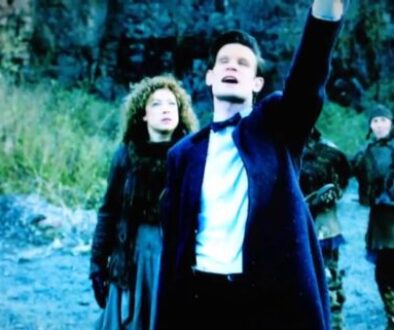Cold War Review
In Defense of ‘Akhaten’

“Actually, I think I may’ve made a bit of a tactical boo-boo. More of a semantics mix-up, really.”
In reading the responses to my review of “The Rings of Akhaten,” it is apparent that several readers feel that I was in error in calling Akhaten a sun, and not a planet, specifically a gas giant. After rewatching the episode yet again, I’d like to respond with a couple of thoughts.
The episode presents many clues that Akhaten is a sun, and not a planet.
When the Doctor first shows the rings of Akhaten to Clara, he comments that she is bathed in the “light of an alien sun” – light which is reddish in color, and obviously coming from Akhaten. True, it is entirely possible that the light is reddish because it is being reflected off of a red planet, but the way the scene is staged, it certainly seems as if Clara is staring at a ring of asteroids surrounding a red sun.
The Doctor describes the Pyramid as being a holy temple that houses the “Sun Singers of Akhat,” who, ostensibly, would be singing to a sun god, hence their name, right? Having had the chance to see the feed from the BBC, complete with captioning (which differs, at times, from the BBC America captioning), I am now aware that the phrase may actually be the “Seven Singers of Akhat,” a reference to the “Seven Worlds.” However, Matt Smith’s delivery sounds like “Se’en Singers,” at best, and my American ears hear “Sun Singers.” Compare the Doctor’s “Se’en Singers” to his following sentence’s “Seven Worlds” – this time, with a distinct “v.” To me, the difference sounds deliberate.
The Doctor tells Clara that the citizens of the Seven Worlds all believe that life in the universe started “on that planet,” and he gestures with his finger towards something in front of them, most likely either Akhaten or the largest of the orbiting planetoids, both of which are directly in front of the Doctor at the moment he gestures. When a fascinated Clara asks if they “can see [that planet], up close,” the Doctor takes her not to the red Akhaten, but to that large planetoid and its vast market, indicating that life started on the planetoid, one of seven worlds orbiting the star Akhaten. (And yes, judging by the scale of the market and the open coliseum, the “planet” is technically too small to be termed anything more than an “asteroid” or a “planetoid,” but I chalked that up to an art department error, rather than a fault in the script.)
More evidence that Akhaten is a star can be found near the episode’s end, as the Doctor and Clara fight the parasite. As presented, Akhaten cannot be a planet – planets don’t implode, nor do they explode as supernovae. Stars do, however. Further, short of faint aurorae around the poles, and possible lightning, gas giants do not give off internal light – they merely reflect their sun’s rays. How then to explain the flaming, orange, vaguely face-shaped light coming from Akhaten’s surface? It can’t be the molten core of a gas giant, because scientists still haven’t determined that gas giants even have solid cores, and if they do, they are most surely made of rocks and ice, not hot, glowing magma, which only exists on terrestrial planets. (And, how exactly would life evolve on a gas giant planet anyway, considering it has no solid surface?) Could the glowing “face” shapes be the parasite itself, which glows orange due to its alien biology? Sure – and I won’t fault anyone for thinking that – but Occam’s razor states that, of competing hypotheses, the one making the fewest assumptions is the correct one, so I went with Akhaten being a star.
Parts of the episode are better, if Akhaten is a star.
While trapped inside the Pyramid with the awakening Mummy, the Doctor tells Merry that all of her constituent elements were formed “in the heart of a . . . star that exploded, and died.” Those elements were scattered across the universe to form “shoes, and ships, and ceiling wax, and cabbages, and kings” . . . and Merry, who is unique in the universe. Taken at face value, the speech is a justification of Merry’s value as an individual, and her right to continue living, should she so choose. However, if Akhaten is a star, the speech serves as both a telegraphed message of strength – “Merry, you were born from the destruction of a star. Fear not that this one wants to eat you!” – but also foreshadows Akhaten’s explosive demise. Pretty awesome, no?
To me, Akhaten’s identity as a ancient, red giant star not only enhances the plot point that all life in the universe supposedly originated within the star system, but also that the “Old God” has been worshiped continuously for “millions of years.” Further, red giant stars burn cooler and dimmer than, say, our bright yellow sun, thus explaining how life on planetoids so close to Akhaten could survive without being scorched.
I’m not the only person who assumed that Akhaten is a star.
I was invited to attend the BBC America-sponsored watch party here in Dallas, where the main conversations after the episode were, “What are the ramifications of the Doctor destroying that ancient solar system?” and “Who are those adorable girls dressed as the Doctor and a Weeping Angel?” (Seriously, those kids were ridiculously cute.) An entire theatre full of people thought that Akhaten was a sun – and not just because BBC America provided free booze!
Heck, I’m not even the only reviewer who referred to Akhaten as something other than a planet; while most critics danced around the matter, io9’s resident critic called Akhaten a “star.”
Based on the preliminary artwork on the BBC Web site, do I believe that Akhaten was meant to be a planet? Yes, though I wasn’t reviewing the supplementary materials, but the episode itself. Was Akhaten effectively portrayed as a planet within the episode? No, which ultimately reinforces a basic tenant of my original article: there is great depth to be found in “The Rings of Akhaten,” but that one must actively dig to find it because the episode’s twists – specifically in regards to its shifting terminology – muddle the portrayal of the plot. Further, regardless of whether Akhaten is a planet or a star, the sudden lack of mass destroys the force of gravity holding the ring system together, thus destroying the ancient, sacred Rings of Akhaten, which will drift off into space over the next several million years. Surely, we are still allowed to question the Doctor’s role in that?
It should be noted that, at no point in the episode does the Doctor specifically call the giant, red, glowing ball of gas “the planet Akhaten.” There are references to an “alien sun,” “that planet,” and “the Rings of Akhaten,” but never “the planet Akhaten.” With no clear definition of Akhaten’s identity established by the episode’s script or visual effects, I went with the definition that, to me, created the least amount of plot holes, and actually enhanced the narrative of the story. However, anyone choosing to believe that Akhaten is a planet (albeit one that somehow contracts and then goes supernova) will receive no criticism from me.








